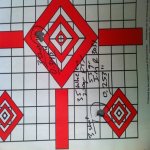If memory serves, IMR3031 was originally developed back in the early 1930s with the 30-06 in mind. It also does very well in smaller cases.
IMR3031 is useful for a lot of different applications, including as a replacement for black powder charges, with appropriate weights of course and usually some sort of case filler, such as the 577-450.
I used to use a lot of IMR3031 in my 257rob, 30-30, 308win, 303Brit, 7x57, 6.5x55,8x57 and 30-06. It's a very decent and consistent powder for those applications but it is noticeably temperature sensitive, when ambient temps drop below -10C.
I still have some surplus bulk powder on hand. Maybe five pounds and only use it in a couple of cartridges. I don't shoot much with my 30-06 anymore, simply because there are so many other good cartridges with less recoil.
I went back to my records for the accuracy load I used in the custom Mauser, with a 24 inch Douglas bbl.
I used 50 grains of IMR3031 over whichever standard large rifle primer I had on hand at the time of reloading, topped with 150 grain bullets.
My records tell me that velocity was averaging 2860fps and pressures were around 48,000 CUP.
The velocity average is from a Chrony and the pressure is according to an old Lyman #45 manual, or so the notes say.
Powders change from batch to batch as far as burn rates go. There are all sorts of factors that may make my preferred load with this powder, unsafe for YOUR RIFLE. I would suggest you start with 45 grains and work up an accuracy load from there.
There are so many good powders available today, that I forget about how much I like IMR3031. My surplus container isn't marked IMR3031. It's just marked with "3031"
I'm dating myself now but back when International was dumping 6.5x55 ammo with wooden bullets onto the market very cheaply, they offered it in packages that included a selection of several weights/profiles of 6.5 bullets ranging from 95 grains up to 160 grains. The 160 cupro nickle jacketed, round nose bullets that had been pulled from rejected lots of ammo.
The cartridges with wooden projectiles needed to be broken down. They were loaded with a Rottweil flake type powder that worked well in pistol cartridges over 35 caliber albeit a bit slow for semi autos.
The package also included one pound containers of Bofors #44 Powder, which had a burn rate almost identical to IMR3031 and were marked to use 3031 reloading data.
It's a really useful powder, under select conditions, for a wide range of applications. Most late manuals no longer carry loading data for IMR3031 in any real detail, for the 30-06, except for light bullets.
You will need to go online and search older manuals for the data you're looking for. I believer the old Lyman #45 manual listed loads, using IMR3031 from 110 grain bullets, all the way up to 220 grain bullets.
This gives you a place to start and do your own due diligence, which you should always be doing to verify any loads you might get off a site such as this. Not that there is any intent to cause you grief. Just a load that is safe in one rifle may not be safe in your rifle.








































































